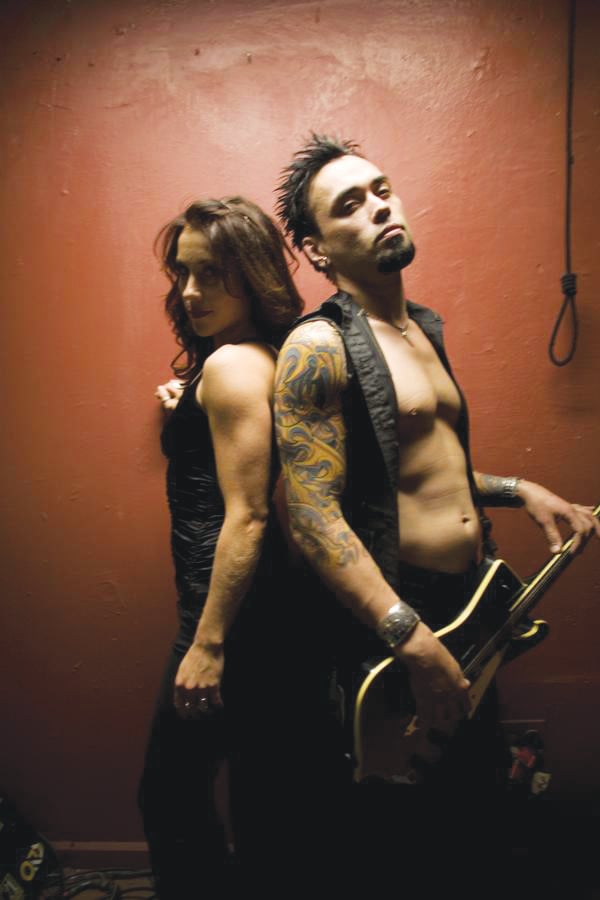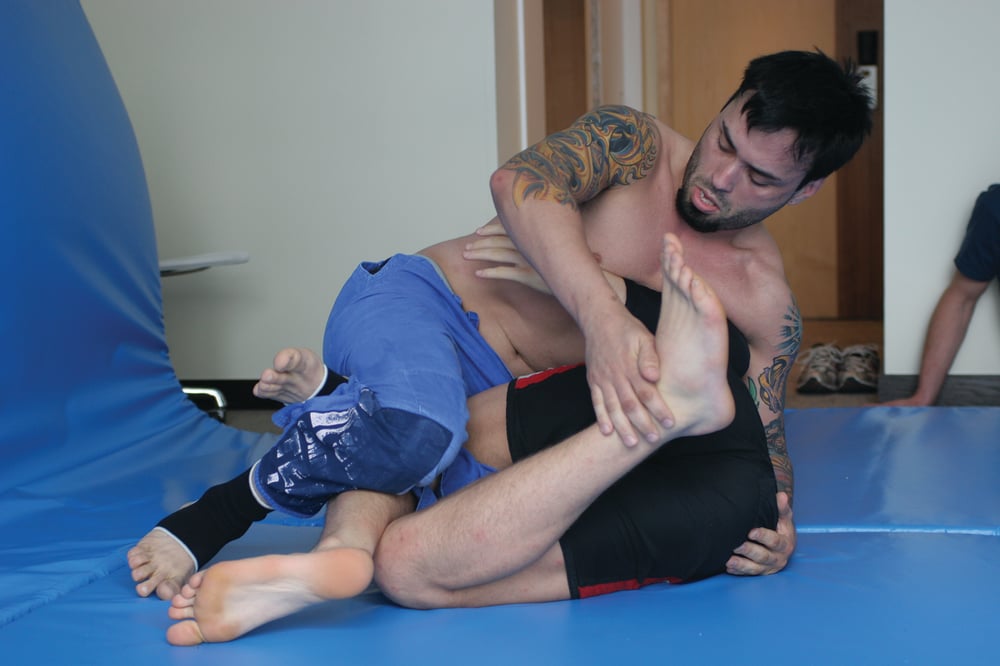
Issue 037
May 2008
Grappler, innovator, trainer, musician, writer, pothead, MMA enthusiast. All of these words describe Edgar Cano, better known as Eddie ‘The Twister’ Bravo. Though he is a man who plays many different roles, mixed martial artists will always know him primarily for one thing – his jiu-jitsu.
While Bravo has never stepped into the UFC Octagon other than to interview a fighter or participated in a mixed martial arts bout, he is nonetheless praised by fighters, trainers and fans for developing what can only be described as a revolutionary style of grappling – a style that Bravo believes is tailor-made for the cage.
Often described as ‘Greco-Roman jiu-jitsu’, Bravo’s unique approach to the yielding art is influencing a whole generation of fighters, making him one of the most sought-after Brazilian Jiu-Jitsu instructors in America. However, the California dweller wasn’t born a fighter. In fact, he had what many jiu-jitsu veterans would call a late start.
“At age 21, I came to Hollywood to be a rock star,” says Bravo. “I didn’t want to be one of those fat guys on stage, so I joined a gym to lift weights. That lasted two days. I realised I can’t hang at a regular gym – it’s too boring. So I signed up for jiu-jitsu with Jean Jacque Machado, and the rest is history.”
Bravo fell in love with the martial art and quickly became a skilled though largely unknown competitor on the BJJ circuit. However, all this changed when, as a brown belt, the Californian defeated the legendary Royler Gracie in the 2003 Abu Dhabi Submission Wrestling Championships. The submission victory not only shocked the grappling community, but it also showcased his unusual style to the MMA world, who simply couldn’t believe that a nobody had beaten one of the best grapplers to walk the planet.
“When I won, it was like winning the Super Bowl,” says Bravo. “I remember standing on the other side of the mat and looking over. It was Royler, the dude I used to watch like 10 years ago. I was about to fight a Gracie! It’s what every jiu-jitsu player dreams of, fighting Royler Gracie, and I actually got the shot to do it!”
Soon after, Bravo received his black belt from Jean Jacque Machado, and he released his first book entitled “Jiu-Jitsu Unleashed”. The text laid out the fundamentals of Bravo’s unique no-gi style and made the young upstart a respectable figure in the MMA world. However, success didn’t come easy, as many jiu-jitsu traditionalists didn’t take kindly to Bravo’s radical views. “I never planned to create a style,” says Bravo. “I just saw too many jiu-jitsu guys not doing anything once they got into the cage and took their gi off, especially in the guard. No armbars, no triangles, just the same old set-ups over and over. It was embarrassing! I wanted to make sure that if I ever did MMA, that wouldn’t happen to me. So I changed my style to no-gi, which made the Brazilians trip.”
Bravo was insulted and even threatened by the Brazilian jiu-jitsu community, many of who saw him as an unproven upstart, a one-trick pony. However, while the jiu-jitsu community cursed him, mixed martial artists took notice of the rebellious grappler. Not
only was his style refreshing, but it also made sense, and was, as Bravo promised, tailor made for MMA. “Training with a gi creates a lot of bad habits,” says Bravo. “But some people, the traditionalists, aren’t ready to admit that. I think there’s a reason why you rarely see Brazilian jiu-jitsu champions having wicked guards in MMA.
“Why is [UFC heavyweight champion] Antonio Nogueira the only guy in the UFC with a good guard? It’s because they’re not evolving, they don’t know how to play guard with over-hooks, under-hooks and head control. They have those habits that come back to haunt them in MMA.”
In 2006 Bravo took his unique style of jiu-jitsu one step further by releasing a second book entitled ‘Mastering the Rubber Guard: Jiu-Jitsu for Mixed Martial Arts Competition’. This time Bravo unveiled the secrets to his freakishly flexible guard game, showing the world that a fighter could treat lying on his back as an entirely offensive position. Once again, traditionalists criticised Bravo’s offensive style, brushing it off as a gimmick. But as time passed, others learnt Bravo’s ‘rubber guard’, and slowly the true genius of his style began to show.

It all began at Pride’s Shockwave 2006, when Japan’s Shinya Aoki (14-2-0) shocked the world by submitting top lightweight Joachim Hansen (16-6-1). In less than 3 minutes, the 24-year-old tapped the highly rated Norwegian with a difficult technique called a gogoplata in textbook Eddie Bravo style. The win was truly an MMA milestone, as not only did Aoki pull off what was supposed to be an impossible technique (in MMA), but he also opened the door to a whole new level of grappling, a level that the vast majority of professional fighters simply weren’t familiar with.
“The problem is, to learn rubber guard, you gotta go through the growing pains,” says Bravo. “You gotta really roll. And guys that are famous, that are already there, they don’t want to go through the growing pains. They’re going to stick to what they know, and not take any chances. They look at me and they say, ‘what does he know, he’s never done MMA’. Luckily, a few fighters have listened to me, Aoki is one of them.”
Apparently, so is UFC veteran Nick Diaz (15-7-0). In early 2007, Diaz, a heavy underdog, used Bravo’s rubber guard and submitted the world’s top ranked lightweight at the time, Takanori Gomi (27-3-0). Though the win was later made a no contest because of a failed drug test, the point had hit home: Eddie Bravo might be worth listening to.

As if it weren’t controversial enough already, Bravo’s new book also included a lengthy chapter on the benefits of grappling while under the influence of marijuana. Bravo, a strong supporter of the legalisation of the drug, stated his view that weed not only enhances creativity, but can also improve coordination, a statement that only added to the mystique already surrounding the world-renowned trainer.
“Marijuana helped me just as much as steroids would help a professional athlete,” says Bravo. “It opens up the arteries and veins in your eyes, more blood rushes through, it opens up your brain to more blood flow, everything feels better. Marijuana is a steroid for the imagination.”
Some fighters, like Nick Diaz, took Bravo’s advice to heart. In fact, in 2007, several high profile grapplers admitted to the use of marijuana during training. Though Bravo refused to incriminate his fellow potheads, the Californian claims that the fans have only seen the tip of the iceberg. “I’m not going to give out names,” says Bravo. “But there’s a ton of fighters who train stoned. It works! I know one guy, some regard him as the greatest American competitor in the world, he trains, and even competes stoned all the time, and kills everyone. All you gotta do is remember this: the greatest college running back is Ricky William. The greatest basketball player was Kareem Abdul Jabbar. The greatest martial artist was Bruce Lee. Guess what? They were all potheads.”
Today, Bravo is known as much for his marijuana advocacy and music career as he is for his grappling. Unfortunately, Bravo’s greatest contribution to the sport, the rubber guard, is still largely uncommon in the UFC and other large MMA organisations. Other men would despair, but the Machado protégé is optimistic, promising that the future has much in store.
“The rubber guard will be everywhere,” says Bravo. “You just gotta give it time. Right now if you go to C and B level shows, you’ll see young guys doing all kinds of crazy things that you don’t see in the UFC. There’s just no way you can stop the rubber guard. Believe me, the next generation is going to be plain scary, and I’m happy that I had something to do with it.”
Go to page 100 for a step-by-step guide to performing one of Bravo’s famous rubber guard techniques, as demonstrated by the man himself.

BRAVO FACTS
Bravo currently runs 10th Planet Jiu-Jitsu, located in the famous Legends MMA gym in Hollywood.
Among his current students are UFC commentator Joe Rogan and Jason Chambers, fighter and co-host of popular TV show Human Weapon.
Bravo is heavily involved in music as both a performer and producer.

During broadcasts, Bravo is employed by the UFC as a jiu-jitsu consultant, and previously conducted post-fight interviews in the Octagon.
Bravo’s first experience of grappling was as a high school wrestler, which is where he first encountered the wrestling move ‘the guillotine’. Since then, he and the Machado’s developed the move to become the fearsome submission known as the twister.
The first ever twister in MMA competition happened on UK soil when Gerald Strebendt, one of Bravo’s top students, submitted Dave Elliot in 2004.
...












